Cheltenham: Difference between revisions
Created page with '{{Infobox town |name=Cheltenham |county=Gloucestershire |picture=Cheltenham.view.arp.jpg |picture caption=The Promenade, Cheltenham |os grid ref=SO950223 |latitude=51.899555 |lon…' |
|||
| Line 118: | Line 118: | ||
*{{dmoz|/Regional/Europe/United_Kingdom/England/Gloucestershire/Cheltenham/|Cheltenham}} | *{{dmoz|/Regional/Europe/United_Kingdom/England/Gloucestershire/Cheltenham/|Cheltenham}} | ||
*[http://www.bbc.co.uk/gloucestershire/content/articles/2008/09/22/dayout_cheltenham_video_feature.shtml BBC archive film of Cheltenham from 1985] | *[http://www.bbc.co.uk/gloucestershire/content/articles/2008/09/22/dayout_cheltenham_video_feature.shtml BBC archive film of Cheltenham from 1985] | ||
[[Category:Spa towns in the United Kingdom]] | |||
Latest revision as of 08:19, 20 October 2017
| Cheltenham | |
| Gloucestershire | |
|---|---|
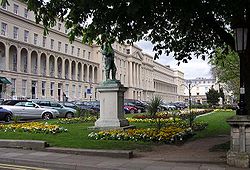 The Promenade, Cheltenham | |
| Location | |
| Grid reference: | SO950223 |
| Location: | 51°53’58"N, 2°4’22"W |
| Data | |
| Post town: | Cheltenham |
| Local Government | |
| Council: | Cheltenham |
Cheltenham, also known as Cheltenham Spa, is a spa town in Gloucestershire, on the edge of the Cotswolds.
The town exudes an image of wealth and respectability. It is the home of the respected race of British steeplechase horse racing, the Cheltenham Gold Cup, the main event of the Cheltenham Festival held every March. The town hosts several festivals of culture. The internationally renowned Cheltenham Ladies' College is here too.
The town
The town was awarded a market charter in 1226, and has been a health and holiday resort since the discovery of mineral springs there in 1716. Horse racing began in Cheltenham in 1815, and became a major national attraction after the establishment of the Cheltenham Festival in 1902.
The small River Chelt flows under and through the town and makes its presence felt on occasion when it floods.[1] The town had a population of 110,013 at the 2001.
Cheltenham has light industry, including food processing, aerospace, electronics and tourism businesses. The Government's electronic surveillance operation "Government Communications Headquarters" (GCHQ), is housed in a distinctive doughnut-shaped building, is in Cheltenham. Vertex Data Science, GE-Aviation, Dowty Rotol, Chelsea Building Society, Endsleigh Insurance, Nelson Thornes, UCAS (Universities & Colleges Admissions Service), Kohler Mira, Zurich Financial Services and Spirax Sarco all have sites in and around Cheltenham.
Cheltenham is a regional shopping centre, home to several shopping centres and department stores, and not just the national chains: Cavendish House was been here since 1823.
History

The town was awarded a market charter in 1226, though little remains of its pre-spa history. Cheltenham has been a health and holiday spa town resort since the discovery of mineral springs there in 1716. The spa waters continue to be taken recreationally at Pittville Pump Room, built for this purpose and completed in 1830.[2] Cheltenham's success as a spa town is reflected in the railway station, which is still called Cheltenham Spa, and spa facilities in other towns that were inspired by or named after it.
Horse racing began in Cheltenham in 1815, and became a major national attraction after the establishment of the Cheltenham Festival in 1902.[3] Whilst the volume of tourists visiting the spa has declined, the racecourse attracts tens of thousands of visitors to each day of the festival each year,[4] with such large numbers of visitors having a significant impact on the town.
The first British jet aircraft prototype, the Gloster E.28/39, was manufactured in Cheltenham. Manufacturing started in Hucclecote near Gloucester, but was later moved to Regent Motors in Cheltenham High St (now the Regent Arcade), considered a location safer from bombing.
Churches
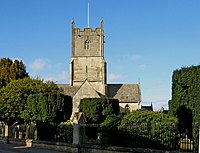
The parish church of Cheltenham is St Mary's, which is the only surviving mediæval building in the town.
As a result of expansion of the population, absorption of surrounding villages, and the efforts of both evangelical and other missions, the town has a large number of other churches. Of these, Trinity Church is one of the largest Anglican congregations outside London. All Saints' in Pittville is where the composer Gustav Holst's father was the organist.
Bellringing
The town has two notable rings of bells hung for change ringing. The first is at St Christopher's (Warden Hill), the lightest ring of church bells in the world.[5] The bells of St Mark's are renowned for their tonal excellence and ease of "handling".[6] The product of John Taylor's Bell Foundry, they were cast in 1885 and 2007 and have undergone a major refurbishment. There is also a ring of 12 bells dating mainly from the 19th century hung in St Mary's Church.
The bells of St Mary's were the venue in 2008 for the eliminators of the National 12 Bell Striking contest, in which teams of campanologists from around the world compete to win the Taylor Trophy. The towers in the locality of Cheltenham belong to the Cheltenham branch of the Gloucester & Bristol Diocesan Association of Church Bell Ringers.
Places and sights of the town
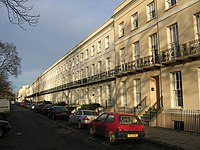
Lansdown Crescent
Lansdown Crescent is a Regency period terrace, designed by John Buonarotti Papworth for R.W. and C. Jearrad and constructed in the 1830s. The Crescent is convex, and opposite the north-eastern part stands Lansdown Court, an Italianate villa possibly designed by Papworth but more probably by the Jearrads and built about 1830.
Montpellier
Montpellier is a part of the town originally developed in the 1830s in conjunction with the spas. It is now known for its bars, cafés, restaurants and range of specialist shops. In April 2008 Montpellier was one of the most expensive areas in Cheltenham to buy property, with apartments ranging from £300,000 to over £1,000,000, townhouses from around £400,000, and houses over £4,000,000.
Charlton Park
Charlton Park[7] (see above map) is a former 72-acre historic park with mansion house, about a mile south-east of the town centre. From 1935 the parkland gradually became a private residential area, the main housing development taking place between 1976 and 1983.
The original mansion house dated from the 13th century; alterations throughout the centuries transformed it from a mediæval, timber-framed hall-house into an 18th-century brick-faced mansion in the classical style. In the 1780s the estate was emparked for deer and had magnificent Dutch-style water gardens. After 1935 the old house became part of Charlton Park Convent, and since 1987 has been part of St Edward's School.
Economy
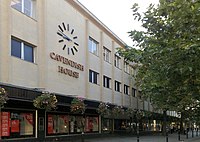
Employment in Cheltenham is a mixture of serveices and light industry, including food processing, aerospace, electronics and tourism businesses. GCHQ is a lare employer and technology and financial services are well represented in and around the town.
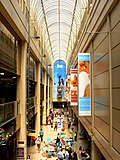
Cheltenham is a regional shopping centre, home to department stores, the oldest being Cavendish House, from 1823,[8] and centres including the Regent Arcade and the Beechwood Shopping Centre. It is well-known locally for its nightlife, with a wide range of pubs, wine bars, clubs and restaurants.
Culture
The town is beautified by its Regency architecture and is said to be "the most complete regency town in England".[9] Many of the buildings are listed, including the Cheltenham Synagogue, judged by Nikolaus Pevsner to be one of the architecturally "best" non-Anglican ecclesiastical buildings in Britain.[10]
The Cheltenham Art Gallery & Museum has a notable collection of decorative arts form the era of the Arts and Crafts Movement.
The Holst Birthplace Museum contains personal belongings of the composer of The Planets Suite, including his piano. It also includes a working Victorian kitchen and laundry, Regency drawing room and an Edwardian nursery.
The Cheltenham Civic Society has placed commemorative plaques on buildings of the town since 1982: blue plaques to celebrate well-known people and green plaques to celebrate significant places and events. A full list of plaques is available here.
Cheltenham Festival
Cheltenham Festival is the most prestigious meeting in the National Hunt racing calendar in the United Kingdom,[11] and has race prize money second only to the Grand National. It is an event where many of the best British and Irish trained horses race against each other, the extent of which is relatively rare during the rest of the season.
The festival takes place annually in March at Cheltenham Racecourse in Cheltenham. The meeting is often very popular with Irish visitors, largely because of that nation's affinity with horse racing, but also because it usually coincides with Saint Patrick's Day, an Irish national holiday.
Large amounts of money are bet during festival week, with hundreds of millions of pounds being gambled over the four days. Cheltenham is often noted for its atmosphere, most notably the "Cheltenham roar", which refers to the enormous amount of noise that the crowd generates as the starter raises the tape for the first race of the festival.
Other Festivals
Every year, Cheltenham Festivals organises music, jazz, literature and science festivals in the town, attracting names with national and international reputations in each field. Events take place at venues including the Town Hall, the Everyman Theatre, The Playhouse Theatre and the Pittville Pump Room.
- Cheltenham Music Festival was founded in 1945 as a festival of British music, but has now become more international. It has been held in June/July since 1945. Many pieces of music have had their premières performance at Cheltenham.
- Cheltenham Literature Festival was founded in 1949. It is held in October.
- Cheltenham Jazz Festival was founded in 1996. It is held in for a week April/May each year
- Cheltenham Science Festival was founded in 2002. It is held in June
Others, separately organised arw:
- Cheltenham Cricket Festival, which features Gloucestershire County Cricket Club
- Cheltenham Folk Festival
- Cheltenham Festival of the Performing Arts (formerly Cheltenham Competitive Festival), a more local event comprising a collection of more than 300 performance competitions, which is the oldest of Cheltenham's arts festivals, having been started in 1926.
- Greenbelt, a Christian arts and music festival, held at Cheltenham Racecourse
- Wychwood, a family-friendly folk and world music festival, held at Cheltenham Racecourse
- Walk the Line Festival, across several venues
In 2010, Cheltenham was named Britain's fifth 'most musical' City by PRS for Music.[12][12]
Sport and leisure
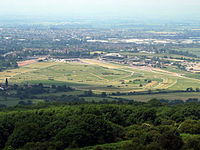
Cheltenham Racecourse is in fact in the nearby village of Prestbury. It is the home of National Hunt racing in the United Kingdom, or steeplechase. Meetings are hosted from October to April.
The highlight of the season is the Cheltenham Gold Cup, which is normally held in the middle of March, during the Cheltenham Festival.
References
- ↑ Environment Agency - Cheltenham
- ↑ BBC Gloucester: Pittville Pump Room information
- ↑ History of the Cheltenham Festival
- ↑ See for example, attendance figures for 2005 here
- ↑ St Christopher's Church
- ↑ St Mark's Bellringers, Cheltenham
- ↑ A History Of Charlton Park local history web site, David Hanks
- ↑ Records of Cavendish House Co Ltd, department store, Cheltenham, Gloucestershire, England and London, England, Archives Hub
- ↑ AA Illustrated Guide to Britain (1997), ISBN 0-393-31643-2
- ↑ The Buildings of England, Nikolaus Pevsner, Penguin Books, 1951, p. 37
- ↑ "Going is good for Cheltenham". BBC Sport. 17 March 1998. http://news.bbc.co.uk/1/hi/sport/66009.stm. Retrieved 10 March 2009.
- ↑ 12.0 12.1 http://www.mirror.co.uk/celebs/news/2010/03/13/bristol-named-britain-s-most-musical-city-115875-22107650/
- Bibliography
- David Verey, Gloucestershire: the Vale and the Forest of Dean, The Buildings of England edited by Nikolaus Pevsner, 2nd ed. (1976) ISBN 0-14-071041-8
- ' Commemorative Plaques of Cheltenham' by Peter Smith & Sue Rowbotham (Reardon, 2009) ISBN 1-873877-93-5.
Outside links
| ("Wikimedia Commons" has material about Cheltenham) |
- Cheltenham Civic Society
- Genealogical Web site including many relevant references on Cheltenham
- Cheltenham at the Open Directory Project
- BBC archive film of Cheltenham from 1985
